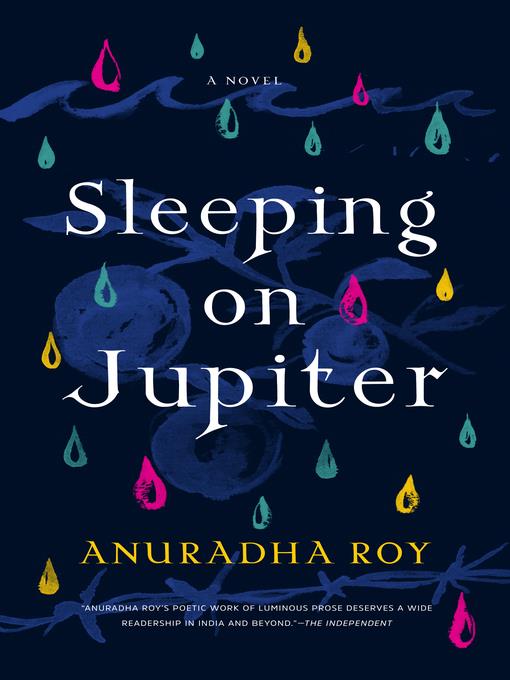
Sleeping on Jupiter
A Novel
کتاب های مرتبط
- اطلاعات
- نقد و بررسی
- دیدگاه کاربران
نقد و بررسی

July 4, 2016
Travelling to India, to a fictional Vishnu temple in a beachside town, Nomi is returning to the land of her birth as well as to the place that haunts her memory. Having lost her family during an unspecified war, Nomi, at age seven, was brought to an ashram, kept captive, and sexually abused by the guru. She escaped at 12, entered an orphanage, was adopted, and taken to Europe. Now living in Norway and in her mid-20s, Nomi comes back to India to work on a documentary film; Roy’s novel sets the stage for her research, as she wanders the beach where she may have last seen her mother and the crumbling bricks and broken glass of what was the ashram compound. The cast of characters includes an earnest temple guide, three older women on pilgrimage, and Nomi’s local production assistant, Suraj, who’s going through a divorce. Many of the flashbacks, though they’re essential for depth and clarity, feel forced, as Roy (The Folded Earth) tries to stitch together the child’s trauma with the adult’s insight. At the same time, however, the overlapping stories make for a rich and absorbing consideration of where the past ends and the present begins.

July 1, 2016
A holiday destination for devout Hindus is not as holy as it claims to be in this Man Booker Prize-longlisted novel.The fictional seaside town of Jarmuli is home to many temples and ashrams, where gurus offer spiritual guidance to Indians and Westerners. The novel opens with a harrowing scene of violence which leaves a young girl orphaned. She's put on a boat to Jarmuli and is taken in by a seemingly benevolent guru. To outsiders, his ashram appears to be a spiritual paradise, but on the inside, there is rampant physical, emotional, and sexual abuse. Later, 25-year-old Nomi Frederiksen, the orphaned girl from the beginning of the novel, recalls these incidents on a return trip to Jarmuli, where she claims to be filming a documentary. On a train, she meets three elderly women named Gouri, Latika, and Vidya, lifelong friends taking one last holiday together before Gouri becomes completely senile. These four travelers come across Badal, a temple guide who lusts after an underage boy, and Johnny Toppo, an old tea seller who sings mournful songs to his customers. Helping Nomi with her documentary is part-time cameraman Suraj, a middle-aged alcoholic who happens to be Vidya's son. The strength of this novel lies in the first-person narration of Nomi, who recounts her tale of loss and abuse in beautiful, unflinching language. Her chapters alternate with chapters told in third person about the secondary characters, which do nothing to move the story forward or shed light on Nomi's past or the legacy of sexual abuse behind the guise of spirituality in India. Gradually, the various threads lose their energy and fail to come together toward a satisfying resolution. The novel raises questions, certainly, but its refusal to tie things up with a neat bow leaves the ending feeling coy and unfairly ambiguous. Though this is far from a perfect novel, there's enough spark in the first-person narration to make it worthwhile.
COPYRIGHT(2016) Kirkus Reviews, ALL RIGHTS RESERVED.

September 1, 2016
Long-listed for the Man Booker Prize, this third novel (after The Folded Earth) by Roy opens with a girl in India experiencing the horror of the murder of her father and brother. She escapes with her mother but later is completely alone. Readers meet her again as Nomita Frederickson, a 25-year-old from Norway traveling to the fictional town of Jarmuli, India, for work as a documentary filmmaker. Spanning five days in spare prose, the narrative follows Nomi's return to Jarmuli, disclosing her life as an orphan at an ashram and the abuse she and the other children there suffered. With the tranquil style occasionally interrupted by violent passages, the novel delivers the shock value of Herman Koch's The Dinner. VERDICT While those who prefer dialog-driven works may find that Roy's rich imagery can make for somewhat sluggish reading, the solid storytelling successfully presents the eye-opening realities of abuse and misogyny in a culture many American audiences may not find familiar. Ultimately, there's much to ponder.--Shirley Quan, Orange Cty. P.L., Santa Ana, CA
Copyright 2016 Library Journal, LLC Used with permission.

August 1, 2016
In Roy's latest novel, following The Folded Earth (2012), the Indian seaside town of Jarmuli is the site for a confluence of the lives and stories of a disparate group of people. All are burdened with secrets, and all are seeking answers along Jarmuli's shoreline, in its temples, and from the people with whom they interact. Gouri, Latika, and Vidya are three elderly ladies on a junket that may prove to be the last trip their declining health and advancing years allow them to take. Badal is their languid tour guide, tormented by his taboo love for a young grifter. Nomi, a filmmaker on assignment with her assistant, Suraj, is drawn to the area because of the notorious role it played in her past. As each character delves more deeply into his or her own personal dramas, the duplicitous aspects of Indian society are exposed, especially religious and moral hypocrisy. With her mastery of atmosphere and setting, Roy illuminates pervading themes of misogyny, abuse, identity, and desire to luminous and provocative effect.(Reprinted with permission of Booklist, copyright 2016, American Library Association.)

























دیدگاه کاربران